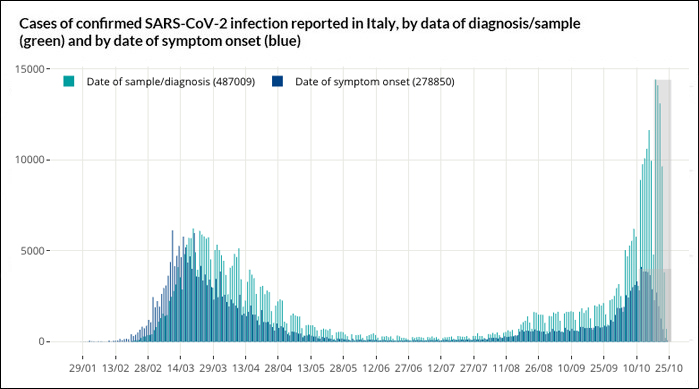The epidemic is worsening rapidly and is generally compatible with a
Type 3 scenario (Prevention of and response to COVID-19: evolution of strategy and planning in the transition phase of the autumn-winter period) with greater increase in some Italian Regions.
The situation described in this report shows signs of criticality in the territorial services, and that critical thresholds within care services of different Regions/Pas will be shortly reached.
There is a strong need for measures, , that may foster a significant reduction in physical interactions between people, especially in the most affected areas of the country. These measures will relieve the pressure on health services, and must include restrictions on non-essential activities and mobility restrictions, as well as the implementation of the other measures already foreseen in the plan “Prevention of and response to COVID-19: evolution of the strategy and planning in the transmission phase for the autumn-winter period”. The Regions/PAs are again invited to carry out a rapid risk analysis, also at sub-regional level, and to consider a timely increase of mitigation measures in the most affected areas.
It is essential that people stay at home whenever possible, reducing all opportunities for contact with people outside their own homes that are not strictly necessary. It should be remembered that it is mandatory to adopt strict individual behaviours, to respect the hygienic-sanitary measures provided for and to use face masks properly.
Key points
- An analysis of the data for the period 12-18 October 2020 is reported. Due to the time between exposure to the pathogen and the development of symptoms, and between these and the diagnosis and subsequent notification, many of the cases reported this week are likely to have contracted the infection between the end of September and the beginning of October. Some of the cases identified by screening, however, may have contracted the infection in earlier periods.
- A strong increase in cases continues to be observed, which brings the cumulative incidence (ISS flow data) in the last 14 days to 146.18 per 100,000 inhabitants (period 5/10-18/10) (vs. 75 per 100,000 inhabitants in the period 28/9-11/10). In the same period, the number of symptomatic cases went from 15,189 (period 28/9-11/10) to 27,114 (period 5/10-18/10).
- The increase in cases is widespread throughout the country, with all Regions/PPAA reporting an increase in the number of cases diagnosed compared to the previous week (MdS flow). This week, only one in four cases was detected through contact tracing activities, while 31.7% was detected through the appearance of symptoms. The percentage of cases detected through screening activities also dropped (25.8% vs. 31.1% in the previous week). In 16.9% of cases, no diagnostic findings were reported.
- In the period 01 – 14 October 2020, the Rt calculated on symptomatic cases is equal to 1.50 (95%CI: 1.09 -1.75). For details on how to calculate and interpret the Rt reported please refer to further information available on the Higher Institute of Health website. Alert signs of resilience by territorial services are reported in all Regions/PAs.
- The epidemic is worsening rapidly and is generally compatible with a Type 3 scenario, with a higher rate of progression in some Italian Regions: in fact, Rt values above 1.25 are found in most Italian Regions/PAs and there are signs that the transmission potential of SARS-CoV-2 is only modestly limited. There is a rapid growth in incidence, an increasingly frequent impossibility to keep track of all transmission chains and a rapid increase in the load on healthcare services, with an increase in hospital bed occupancy rates in both critical and non-critical areas.
- There are a total of 7,625 active outbreaks, of which 1,286 new, so even though the number of active outbreaks is increasing, for the first time in eleven weeks the number of new outbreaks is decreasing (in the previous week of monitoring, 4,913 active outbreaks were reported, of which 1,749 new). This decrease is probably due to the sharp increase in cases for which the territorial services could not identify an epidemiological link: 23,018 cases not associated with known transmission chains were reported (compared to 9,291 last week), which corresponds to 43.5% of the total number of cases reported this week. Outbreaks were reported in almost all provinces (106/107). Most of these outbreaks continue to occur at home (81.7%), which is currently a context of amplification of viral circulation and not the real engine of the epidemic.
- This week there has been an increase in the number of outbreaks where transmission could have taken place in schools, even though intra-school transmission still appears to be limited (3.5% of all new outbreaks reported). However, extra-curricular and peri-school activities could be a trigger for transmission chains if the designed prevention measures are not respected.
- This week, at national level, there has been an important increase in the number of hospitalised people (7,131 vs 4,519 in the medical area, 750 vs 420 in intensive care on 18/10 and 11/10, respectively) and, consequently, there has been an increase in the occupancy rates of hospitalisations in the medical area and in intensive care, with some Regions/PPAA above 10% in both areas. If the epidemiological trend maintains the current pace, there is a high probability that many Regions/PPAA will reach critical employment thresholds in a truly short time.
Fonte Salute.gov.it News
